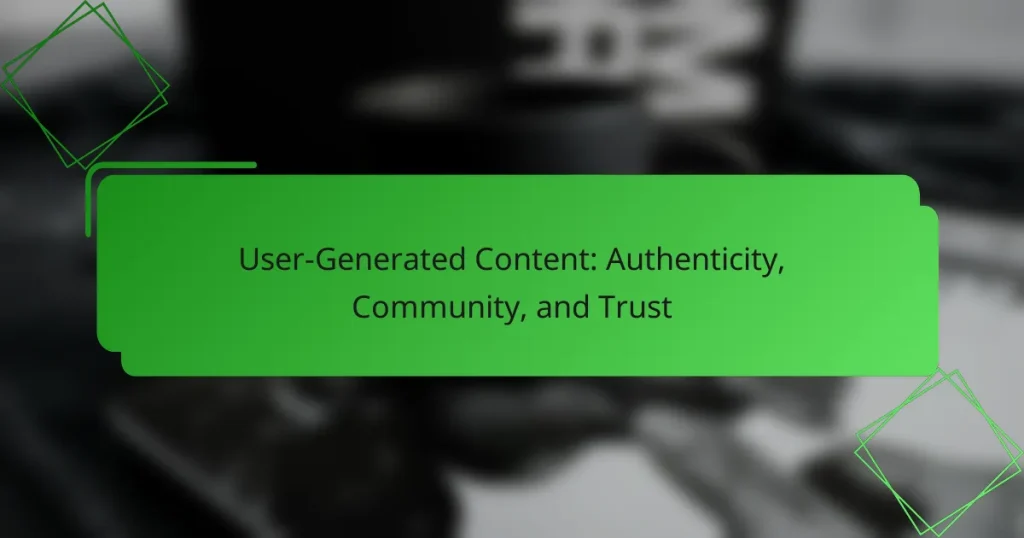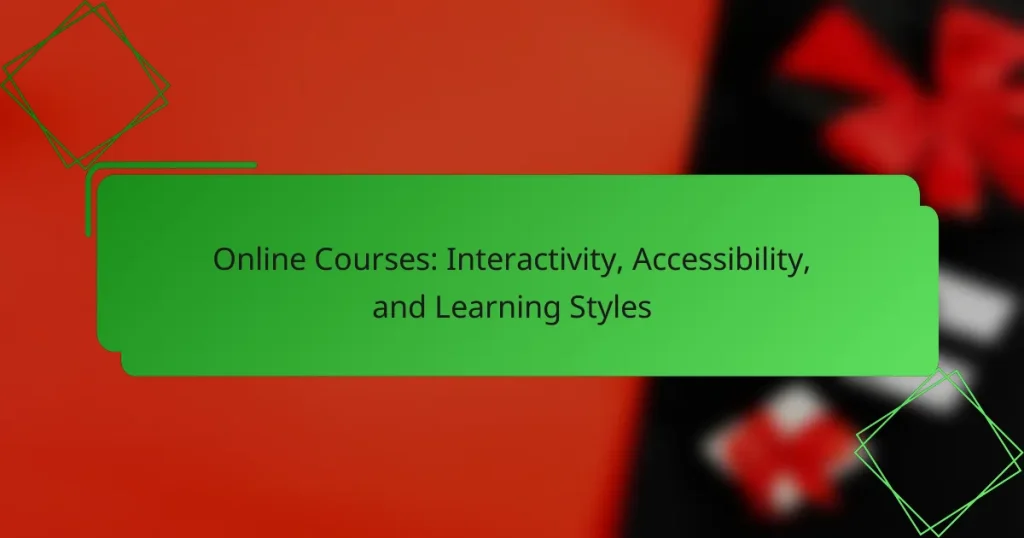Creating engaging digital content is essential for capturing attention and sustaining interest in today’s fast-paced online environment. By leveraging storytelling, multimedia elements, and interactive features, content creators can significantly enhance user experience and effectiveness. Additionally, utilizing the right tools and measuring engagement metrics can further optimize content quality and reach.
User-Generated Content: Authenticity, Community, and Trust
Visual Storytelling: Engagement, Retention, and Brand Connection
Online Courses: Interactivity, Accessibility, and Learning Styles
E-books: Structure, Engagement, and Design
Video Content: Quality, Format, and Learning Impact
Feedback: Improvement, Adaptation, and User Satisfaction
How to create engaging digital content?
Creating engaging digital content involves using techniques that capture attention and maintain interest. Focus on storytelling, multimedia, user experience, interactivity, and SEO to enhance your content’s appeal and effectiveness.
Utilize storytelling techniques
Storytelling is a powerful way to connect with your audience. By weaving narratives into your content, you can evoke emotions and make your message more relatable. Consider using characters, conflict, and resolution to structure your stories effectively.
For example, a case study can illustrate how a product solved a problem for a customer, making the content more engaging. Aim to create a narrative arc that keeps readers invested from beginning to end.
Incorporate multimedia elements
Multimedia elements like images, videos, and infographics can significantly enhance engagement. These components break up text and provide visual interest, making it easier for users to absorb information. Aim for a balance between text and visuals to maintain clarity.
For instance, a tutorial can be more effective with a video demonstration alongside written instructions. Ensure that multimedia elements are relevant and support the overall message of your content.
Optimize for user experience
User experience (UX) is crucial for keeping visitors on your site. A well-organized layout, fast loading times, and mobile responsiveness are essential components. Use clear navigation and intuitive design to help users find what they need quickly.
Consider conducting usability tests to identify areas for improvement. Avoid cluttered designs and ensure that your content is easy to read, with appropriate font sizes and line spacing.
Leverage interactive content
Interactive content, such as quizzes, polls, and calculators, encourages user participation and can increase engagement. This type of content allows users to actively engage with your material, making their experience more memorable.
For example, a quiz related to your topic can provide personalized results, keeping users invested in the content. Ensure that interactive elements are easy to use and seamlessly integrated into your overall content strategy.
Implement SEO best practices
SEO is vital for ensuring your content reaches a wider audience. Use relevant keywords, meta descriptions, and alt tags to improve search engine visibility. Regularly updating your content can also help maintain its relevance in search results.
Consider using tools like Google Analytics to track performance and identify opportunities for optimization. Avoid keyword stuffing; instead, focus on natural language that resonates with your audience while still being search-friendly.
What tools enhance content creation?
Several tools can significantly enhance content creation by streamlining processes and improving quality. These tools cater to various aspects of content, including graphic design, video production, research, and writing assistance.
Canva for graphic design
Canva is a user-friendly graphic design platform that allows users to create visually appealing content without needing extensive design skills. It offers a wide range of templates for social media posts, presentations, and marketing materials.
To get started, select a template that fits your needs, customize it with your text and images, and download it in your preferred format. Canva also provides collaboration features, making it easy to work with teams.
Adobe Spark for video content
Adobe Spark is an intuitive tool for creating engaging video content quickly. It allows users to combine images, text, and music to produce professional-looking videos suitable for social media and websites.
Users can choose from various templates and themes, making it simple to create videos that align with their brand. Keep videos short, ideally under two minutes, to maintain viewer engagement.
BuzzSumo for content research
BuzzSumo is a powerful content research tool that helps identify trending topics and popular content in your niche. It allows users to analyze what type of content performs well across different platforms.
By entering keywords related to your industry, you can discover high-performing articles, videos, and infographics. This insight can guide your content strategy and help you create relevant and timely material.
Grammarly for writing assistance
Grammarly is an essential writing tool that helps improve grammar, punctuation, and style. It provides real-time feedback as you write, ensuring your content is polished and professional.
Utilize Grammarly’s suggestions to enhance clarity and conciseness. The premium version offers advanced features like tone detection and plagiarism checks, which can be particularly useful for professional writing.
How to measure content engagement?
Measuring content engagement involves analyzing various metrics that indicate how users interact with your content. Key indicators include user metrics, social media shares, and conversion rates, which together provide a comprehensive view of engagement levels.
Track user metrics with Google Analytics
Google Analytics is a powerful tool for tracking user engagement metrics such as page views, average session duration, and bounce rates. These metrics help you understand how users navigate through your content and identify which pieces resonate most with your audience.
To effectively use Google Analytics, set up goals that align with your content objectives. For example, if your goal is to increase newsletter sign-ups, track the conversion rate of users who visit your sign-up page after engaging with specific content.
Analyze social media shares
Social media shares are a clear indicator of how engaging your content is. Monitoring the number of shares across platforms like Facebook, Twitter, and LinkedIn can provide insights into what content is most appealing to your audience.
Consider using tools like BuzzSumo or native analytics from social media platforms to track shares and engagement. Aim for a diverse range of shares; high engagement on one platform might not translate to others, so evaluate performance across multiple channels.
Monitor conversion rates
Conversion rates measure how effectively your content drives desired actions, such as purchases, sign-ups, or downloads. A higher conversion rate typically indicates that your content is engaging and persuasive.
To improve conversion rates, ensure your content includes clear calls to action (CTAs) and aligns with user intent. Regularly test different CTAs and content formats to see what yields the best results, adjusting your strategy based on performance data.
What are the best practices for digital content marketing?
The best practices for digital content marketing focus on understanding your audience, leveraging email campaigns, and engaging on social media. These strategies help create relevant and compelling content that resonates with your target market.
Define target audience clearly
Clearly defining your target audience is crucial for effective digital content marketing. Start by creating detailed buyer personas that include demographics, interests, and pain points. This helps tailor your content to meet their specific needs.
Consider using surveys or analytics tools to gather data about your audience. This information can guide your content strategy and ensure you’re addressing the right topics that matter to your audience.
Utilize email marketing campaigns
Email marketing campaigns are a powerful tool for reaching your audience directly. Segment your email list based on interests or behaviors to send personalized content that increases engagement. Aim for a consistent schedule to keep your audience informed and interested.
Incorporate compelling subject lines and clear calls to action in your emails. Tools like A/B testing can help you refine your approach and improve open and click-through rates over time.
Engage with social media platforms
Engaging with social media platforms allows you to connect with your audience in real-time. Choose platforms that align with your target demographic and share content that encourages interaction, such as polls, questions, or user-generated content.
Monitor your social media channels for feedback and respond promptly to comments or messages. This not only builds community but also enhances brand loyalty and trust among your audience.
What are the prerequisites for effective content strategy?
Effective content strategy requires a solid understanding of your audience and a clear set of objectives. These prerequisites ensure that your content resonates with users and achieves desired outcomes.
Conduct market research
Market research is essential for identifying your target audience’s needs, preferences, and behaviors. Utilize surveys, interviews, and analytics to gather data that informs your content direction.
Consider segmenting your audience based on demographics, interests, and pain points. This segmentation allows for tailored content that speaks directly to each group, increasing engagement and relevance.
Establish clear goals
Setting clear goals is crucial for guiding your content strategy. Define what you want to achieve, whether it’s increasing brand awareness, generating leads, or driving sales.
Use the SMART criteria—Specific, Measurable, Achievable, Relevant, Time-bound—to create actionable goals. For example, aim to increase website traffic by 20% over six months through targeted content marketing efforts.
How to adapt content for different platforms?
Adapting content for different platforms involves understanding the unique characteristics and audience preferences of each medium. Tailoring your message ensures better engagement and effectiveness across various channels.
Tailor content for social media
When creating content for social media, focus on brevity and visual appeal. Each platform has its own style; for instance, Instagram thrives on high-quality images, while Twitter favors concise text and hashtags.
Consider the audience’s behavior on each platform. For example, Facebook users often engage with longer posts that tell a story, while TikTok users prefer quick, entertaining videos. Adjust your content format accordingly to maximize reach and interaction.
To enhance engagement, use platform-specific features like polls on Instagram Stories or threads on Twitter. Always keep your messaging consistent with your brand while adapting the tone and style to fit the platform’s culture.






